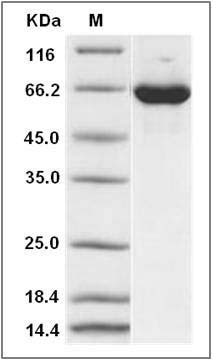-
Product Name
Mouse ERK2 / MAPK1 / MAPK2 (His & GST Tag) recombinant protein
- Documents
-
Description
MAP kinases, also known as extracellular signal-regulated kinases (ERKs), act as an integration point for multiple biochemical signals, and are involved in a wide variety of cellular processes such as proliferation, differentiation, transcription regulation and development. ERK is a versatile protein kinase that regulates many cellular functions. Growing evidence suggests that extracellular signal-regulated protein kinase 1/2 (ERK1/2) plays a crucial role in promoting cell death in a variety of neuronal systems, including neurodegenerative diseases. It is believed that the magnitude and the duration of ERK1/2 activity determine its cellular function. Activation of ERK1/2 are implicated in the pathophysiology of spinal cord injury (SCI). ERK2 signaling is a novel target associated with the deleterious consequences of spinal injury. ERK-2, also known as Mitogen-activated protein kinase 1 (MAPK1), is a member of the protein kinase superfamily and MAP kinase subfamily. MKP-3 is a dual specificity phosphatase exclusively specific to MAPK1 for its substrate recognition and dephosphorylating activity. The activation of MAPK1 requires its phosphorylation by upstream kinases. Upon activation, MAPK1 translocates to the nucleus of the stimulated cells, where it phosphorylates nuclear targets. MAPK1 is involved in both the initiation and regulation of meiosis, mitosis, and postmitotic functions in differentiated cells by phosphorylating a number of transcription factors such as ELK1. MAPK1 acts as a transcriptional repressor which represses the expression of interferon gamma-induced genes. Transcriptional activity is independent of kinase activity. The nuclear-cytoplasmic distribution of ERK2 is regulated in response to various stimuli and changes in cell context. Furthermore, the nuclear flux of ERK2 occurs by several energy- and carrier-dependent and -independent mechanisms. ERK2 has been shown to translocate into and out of the nucleus by facilitated diffusion through the nuclear pore, interacting directly with proteins within the nuclear pore complex, as well as by karyopherin-mediated transport. ERK2 interacts with the PDE4 catalytic unit by binding to a KIM (kinase interaction motif) docking site located on an exposed beta-hairpin loop and an FQF (Phe-Gln-Phe) specificity site located on an exposed alpha-helix. These flank a site that allows phosphorylation by ERK, the functional outcome of which is orchestrated by the N-terminal UCR1/2 (upstream conserved region 1 and 2) modules.
-
Protein name
Mitogen-activated protein kinase 1
-
Uniprot ID
P63085
-
Gene Name
Mapk1; Erk2; Mapk; Prkm1
-
Source/Expression Host
Baculovirus-Insect Cells
-
Expression Plasmid/cDNA
A DNA sequence encoding the mouse MAPK1 (P63085) (Met1-Ser358) was fused with the N-terminal polyhistidine-tagged GST tag at the N-terminus.
-
Protein Species
Mouse
-
Molecular weight
The recombinant mouse MAPK1/GST chimera consists of 595 amino acids and has a calculated molecular mass of 69.1 kDa. The recombinant protein migrates as an approximately 60 kDa band in SDS-PAGE under reducing conditions.
-
Purity
> 96 % as determined by SDS-PAGE
-
Activity
No Kinase Activity
-
Validations

Mouse ERK2 / MAPK1 / MAPK2 Protein (His & GST Tag) SDS-PAGE
Related Products / Services
Please note: All products are "FOR RESEARCH USE ONLY AND ARE NOT INTENDED FOR DIAGNOSTIC OR THERAPEUTIC USE"
